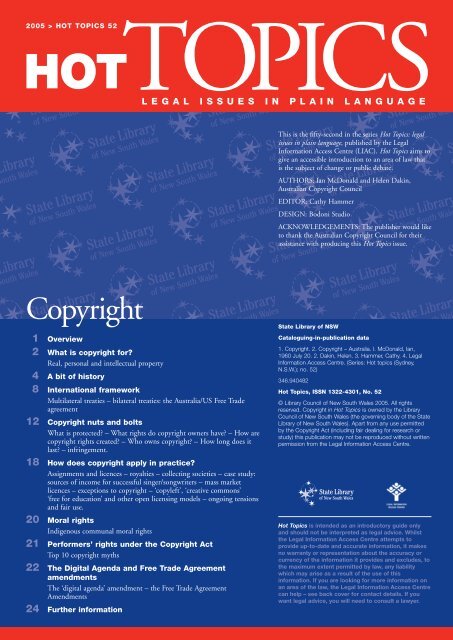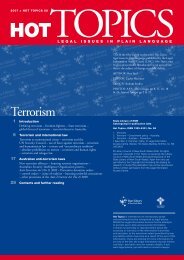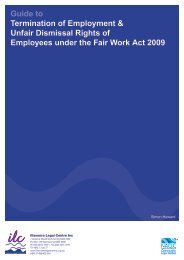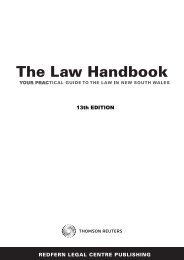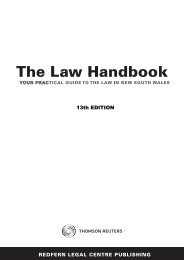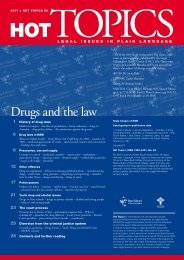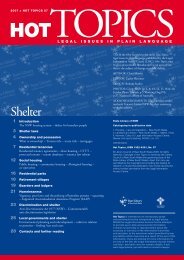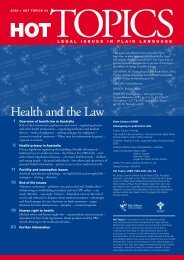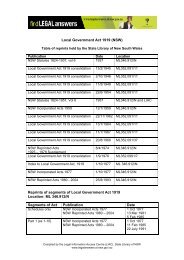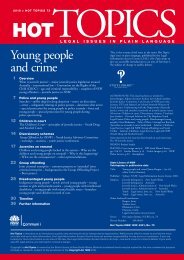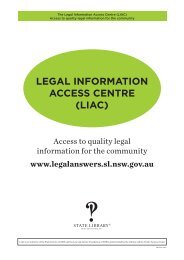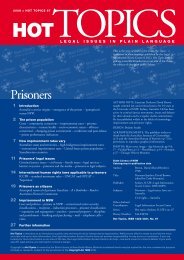Copyright - Legal Information Access Centre
Copyright - Legal Information Access Centre
Copyright - Legal Information Access Centre
You also want an ePaper? Increase the reach of your titles
YUMPU automatically turns print PDFs into web optimized ePapers that Google loves.
HOTTOPICS2005 > TOPICS 52LEGAL ISSUES IN PLAIN LANGUAGEThis is the fifty-second in the series Hot Topics: legalissues in plain language, published by the <strong>Legal</strong><strong>Information</strong> <strong>Access</strong> <strong>Centre</strong> (LIAC). Hot Topics aims togive an accessible introduction to an area of law thatis the subject of change or public debate.AUTHORS: Ian McDonald and Helen Dakin,Australian <strong>Copyright</strong> CouncilEDITOR: Cathy HammerDESIGN: Bodoni StudioACKNOWLEDGEMENTS: The publisher would liketo thank the Australian <strong>Copyright</strong> Council for theirassistance with producing this Hot Topics issue.<strong>Copyright</strong>1 Overview2 What is copyright for?Real, personal and intellectual property4 A bit of history8 International frameworkMultilateral treaties – bilateral treaties: the Australia/US Free Tradeagreement12 <strong>Copyright</strong> nuts and boltsWhat is protected? – What rights do copyright owners have? – How arecopyright rights created? – Who owns copyright? – How long does itlast? – infringement.18 How does copyright apply in practice?Assignments and licences – royalties – collecting societies – case study:sources of income for successful singer/songwriters – mass marketlicences – exceptions to copyright – ‘copyleft’, ‘creative commons’‘free for education’ and other open licensing models – ongoing tensionsand fair use.20 Moral rightsIndigenous communal moral rights21 Performers’ rights under the <strong>Copyright</strong> ActTop 10 copyright myths22 The Digital Agenda and Free Trade AgreementamendmentsThe ‘digital agenda’ amendment – the Free Trade AgreementAmendments24 Further informationState Library of NSWCataloguing-in-publication data1. <strong>Copyright</strong>. 2. <strong>Copyright</strong> – Australia. I. McDonald, Ian,1960 July 20. 2. Dakin, Helen. 3. Hammer, Cathy. 4. <strong>Legal</strong><strong>Information</strong> <strong>Access</strong> <strong>Centre</strong>. (Series: Hot topics (Sydney,N.S.W.); no. 52)346.940482Hot Topics, ISSN 1322-4301, No. 52© Library Council of New South Wales 2005. All rightsreserved. <strong>Copyright</strong> in Hot Topics is owned by the LibraryCouncil of New South Wales (the governing body of the StateLibrary of New South Wales). Apart from any use permittedby the <strong>Copyright</strong> Act (including fair dealing for research orstudy) this publication may not be reproduced without writtenpermission from the <strong>Legal</strong> <strong>Information</strong> <strong>Access</strong> <strong>Centre</strong>.Hot Topics is intended as an introductory guide onlyand should not be interpreted as legal advice. Whilstthe <strong>Legal</strong> <strong>Information</strong> <strong>Access</strong> <strong>Centre</strong> attempts toprovide up-to-date and accurate information, it makesno warranty or representation about the accuracy orcurrency of the information it provides and excludes, tothe maximum extent permitted by law, any liabilitywhich may arise as a result of the use of thisinformation. If you are looking for more information onan area of the law, the <strong>Legal</strong> <strong>Information</strong> <strong>Access</strong> <strong>Centre</strong>can help – see back cover for contact details. If youwant legal advice, you will need to consult a lawyer.
Overview<strong>Copyright</strong> has been in the news a lot over thepast couple of years – and it doesn’t always getgood press. It is easier and cheaper than everbefore to make and distribute perfect copies.Some people lose sight of the fact that suchcopying, even when the copier isn’t makingmoney from it, makes it harder for the creators ofthe material to earn a living.This issue of Hot Topics looks at what is covered by the<strong>Copyright</strong> Act 1968 and also how copyright applies inpractice in Australia. Of particular interest is the waycopyright is developing in relation to the music and filmindustries and the internet, so some important recentcourt cases and some changes that could be made to theAct in the near future are examined. The issue also covershow copyright law interacts with other areas of law, suchas contract law.Under the Commonwealth Constitution, 1 copyright is afederal responsibility, and therefore the <strong>Copyright</strong> Act isCommonwealth legislation. The Act doesn’t just deal withcopyright. It also sets out the law in relation to a numberof other issues. In summary, the Act deals with threedifferent sets of rights:> copyright rights (which are essentially economic innature, as they generally allow the copyright owner tocharge other people money in return for permission touse the material in particular ways);> ‘moral’ rights (not actually rights dealing withmorality, but rights which deal with safeguarding the‘reputation or honour’ of people who create things,and give creators a right to get proper credit for theirwork); and> performers’ rights (which allow performers tocontrol who records them and how and when they arerecorded, and which will soon also include rightssimilar to the moral rights of creators).The Act also has some minor provisions that deal withother issues such as when directors of films and TVprograms can get additional money for screening of theirfilms or programs, and when people who publish thingsare required to give the National Library copies of theirpublications (‘legal deposit’) 2 . Similar requirements alsoexist under various states’ legislation.These sets of rights are balanced by provisions in the Actthat allow people, in specific situations, to do thingswhich would otherwise need permission or consent fromthe copyright owner, the creator or the performer. Thesetypes of provisions are referred to as exceptions, becausethey are exceptions to the general rule that permission orconsent is needed to do something.<strong>Copyright</strong> is a complex area of law that has developedover a number of centuries to respond to different typesof economic and social pressures. The process of finetuningthe Act and making sure it’s doing its job has beenparticularly important over the past decade in response totechnological developments such as the internet thatmake different uses of copyright material possible.Wayne Taylor, The Age, Melbourne.image unavailable1. Paragraph 51(xviii) Commonwealth of Australia Constitution Act.2. See the National Library’s website at http://www.nla.gov.au/services/ldeposit.htmlOverview 1
Whatis copyright for?If you own copyright in something that otherpeople want to use, you can ask for payment inreturn for giving permission. You can alsogenerally stop other people from using thatmaterial.<strong>Copyright</strong> rights therefore serve an important economicfunction. They provide legal back-up to a whole series ofindustries, including:> the film and TV industries> the music industry> the book, newspaper and magazine publishing industry> the multimedia industry> the software industry.<strong>Copyright</strong> can be seen as the law’s continuing answer tothe question: ‘why would people invest time and moneyinto the various creative and cultural industries if otherpeople can just immediately copy what they have createdor produced?’A report by the Allen Consulting Group in 2001 foundthat, in 1999-2000, Australia’s copyright industriescontributed $19.2 billion in industry gross product(IGP). In terms of value adding, this represented 3.3percent of Australia’s Gross Domestic Product (GDP).The report also found that the value-added contributionof Australia’s copyright industries to the Australianeconomy is increasingly important 3 .image unavailableVillage Roadshow Cinemas in George Street, Sydney.Brendan Esposito, SMH.3. Report available at http://www.allenconsult.com.au/resources/<strong>Copyright</strong>.pdf2HOT TOPICS 52 > <strong>Copyright</strong>
The copyright industries would find it much harder tooperate if other people could freely copy their work andproducts and undercut their price without the sameinvestment (including in research and development).The people who are supported by these industries don’tjust include shareholders in multi-national companies,but also all the small businesses and individuals who workin them, such as musicians, writers, photographers,actors, programmers, props makers, and so on.Current arguments about whether or not we should havestrong copyright laws often refer to statistics. Oneexample of the effect of piracy (large-scale infringement)on copyright industries is the decline in the Hong Kongfilm industry, which was once the third-largest producerof movies (after Hollywood and ‘Bollywood’ – the Indianfilm industry). In the 1980s, the Hong Kong industryproduced about 300 films per year, but in 2004 itproduced just 64. The decline has been attributed toorganised groups of people running off pirated copies ofvideos and DVDs and also, more recently, to peoplesharing files online without permission. There are reportsthat, as at 26 April 2005, the movie House of Fury wasfound to have been downloaded more than a milliontimes. Industry estimates of the unauthorised distributionof Chinese movies online in 2004 alone calculate that costthe Hong Kong industry up to HK$400 million (that is,over AUS$67 million). There are even larger statisticsused about the number of people downloading softwareand recordings of their favourite bands withoutpermission.However, copyright does not just protect large industriesand the people working in them. It also protects thework of creative people doing things as individuals –whether on a personal or hobby basis – and creativepeople working outside industry frameworks, who donot want their work and creativity being copied outsidetheir control.P Brunotte.image unavailableREAL, PERSONAL AND INTELLECTUAL PROPERTY<strong>Copyright</strong> law is part of a set of laws that are generally referred to as ‘intellectual property’ laws – or ‘IP’ for short.IP laws are different to laws that involve physical property such as land and houses, fridges, watches and bicycles;IP laws seek to protect something which can’t be touched or seen. Some other examples of IP laws include:> patent (protects inventions and ways of doing things)> designs (protects the look of industrially produced items)> confidential information (protects secret ideas and information)> plant breeder’s rights (protects plant varieties which people develop).For more information on these other areas of IP law, see .Some definitions:real property: area of law which deals with land and buildingspersonal property: area of law which deals with personal belongingsintellectual property: areas of law that deal with protection of creative or intellectual effort, ‘products of the mind’What is it for? 3
A bit of historyThe invasion and settlement first of New SouthWales and then of the other Australian coloniesbrought British law – including copyright law – toAustralia. Although there are a number ofdifferences, the current Australian <strong>Copyright</strong> Act(the <strong>Copyright</strong> Act 1968) is derived from theBritain’s 1956 <strong>Copyright</strong> Act, and many of itsfeatures are derived from older British legislationand court cases.The British <strong>Copyright</strong> Act of 1709 (often referred to as‘the Statute of Anne’) is generally recognised as the firstmodern copyright-type legislation in the Englishspeakingworld. This Act gave authors the sole right ofprinting their books for a period of 14 years after firstpublication, which was automatically extended foranother 14 years if the author was still alive at the endof the first 14 years. The problem addressed by thelegislation was ‘press-piracy’. Daniel Defoe – the authorof Robinson Crusoe – summed up the problem in 1705:… continual Roberies, Piracies, and Invasions ofProperty, range among the Occupation.One Man Studies Seven Year, to bring a finish’dPeice into the World, and a Pyrate Printer,Reprints his Copy immediately, and Sells it for aquarter of the Price. 4image unavailableIn the succeeding centuries, different groups of creatorsand artisans successfully lobbied the British parliament togive them similar protection and rights. For example,legislation to protect engravers of historical prints, mapmakers, sculptors and calico print designers was passedin the 18th century; and in the 19th century, dramatists,authors of lectures and composers succeeded inpersuading the British parliament that passing legislationwas necessary to protect their interests.By the end of the 19th century, a whole patchworkof laws dealing with what we would recognise ascopyright issues covered different types of material indifferent types of ways. The British government set upa Royal Commission to look at the whole issue. TheCommission’s recommendations led to the passing ofthe British <strong>Copyright</strong> Act 1911, which didn’t entirelyeliminate all the quirks and inconsistencies in copyrightlaw, but did for the first time provide more thoroughgoingand thought-through law.The British 1911 Act was adopted as Australian law in1912.4. From A Review of the Affairs of France, 8 November 1705 quoted in On the Origin of the Right to Copy by Ronan Beazley, Hart Publishing 2004.4HOT TOPICS 52 > <strong>Copyright</strong>
At many stages, changes in copyright law resulted from disagreements between different groups in society, and atmany points, the introduction or extension of copyright rights was contentious. In many ways, the types ofarguments which raged over these early pieces of copyright legislation have a very modern ring to them.One of the best known illustrations is Macaulay who, during the 1842 House of Commons debates on copyrightlegislation, argued against extending copyright protection on the grounds that, while giving a ‘bounty to authors’,it was ‘a tax on readers’, and should last no longer than necessary.More recently, there have been commentators and academics such as John Perry Barlow who argue that copyrighthas out-lived its usefulness. In a very influential essay, Barlow argued that, in a digital world, copyright and otherintellectual property laws were now protecting ideas, not the expression of ideas: see.Other commentators and academics, on the other hand, oppose any extensions to current copyright protections, andurge creators to deal with their copyright in new and open ways – for example, by allowing other people to freely useand re-mix their material. See, for example, Lawrence Lessig’s site at .image unavailableThe Statute of Anne (British <strong>Copyright</strong> Act of 1709)‘An Act for the Encouragement of Learning’.House of Lords Records Office, UK.A bit of history 5
InternationalframeworkAt the same time as copyright law wasdeveloping in Britain similar developmentswere happening in other countries – particularlyin Europe. By the middle of the 19th century,the problem of international piracy was ofincreasing concern, and quite a few countriesbegan to enter into bilateral treaties andconventions under which they agreed to givecopyright protection to each other’s nationalsand citizens.In 1886, the Berne Convention – the first of a number ofimportant multilateral treaties – was agreed betweenGreat Britain and some 19 other countries, includingBelgium, Denmark, France, Germany, Japan and Tunisia.The Convention set out minimum levels of copyrightprotection countries would give to the citizens andnationals of the other signatoriesSince that time, international considerations have been anincreasingly strong influence on the way countriesindividually approach copyright law.Similarly, in the 20th century, Australian law hasn’tdeveloped on its own – it has developed in a globalcontext within the international framework of treatiesthat Australia has decided to sign and implement.The most important treaties are multilateral – that is, theyare treaties between many countries. However some morerecent ones are bilateral (between two parties only).image unavailableDomino Postiglione, SMH.6HOT TOPICS 52 > <strong>Copyright</strong>
MULTILATERAL TREATIESThe most important of the international treaties fromAustralia’s point of view are:> the Berne Convention (including two additionaltreaties that are often referred to as the ‘internettreaties’, which form ‘add-ons’ to the Berne Conventionand which update the Berne Convention in light ofdigital communication developments such as theinternet and email)> TRIPs (Trade Related aspects of Intellectual Property),which is a part of another important world tradeagreement, the General Agreement on Tariffs and Trade– GATT.Australia has been a signatory to the Berne Convention inits own right since 1927, and has since signed quite a fewother treaties dealing with copyright issues. It has yet tosign the two ‘internet treaties’, but is expected to do so inthe near future. (Most of the obligations under thosetreaties have in fact been met by Australia as a result ofchanges to our copyright law over the past five years.)The Berne Convention and the ‘internet treaties’ areadministered by the World Intellectual PropertyOrganisation (WIPO), a specialised agency of the UN.TRIPs is administered by the World Trade Organisation(WTO). For more information on the UN system seeHot Topics 31: International Law.Essentially, the Berne Convention and TRIPs arecomplementary – in fact, it is a requirement of signing upto TRIPs that a country provide copyright protectionwhich at least meets the minimal standards set out in theBerne Convention.The basis for the principles in the international treaties isexpressed in Article 27(2) of the Universal Declaration ofHuman Rights, which provides that:Everyone has the right to the protection of the moral andmaterial interests resulting from any scientific, literary orartistic production of which he is the author.For more information on the treaties and on WIPO andWTO see the following websites: and .image unavailableSound recordings are covered by copyright, under thecategory ‘subject matter other than works’, and areseparate from the material that is recorded.BILATERAL TREATIES:THE AUSTRALIA/US FREE TRADEAGREEMENTIn some cases, Australia has entered into treaties withindividual countries. These types of treaties – referred toas ‘bilateral’ treaties – only impose obligations on twocountries.Since 1886 and the signing of the Berne Convention,bilateral relationships have been less important to thedevelopment of copyright than multilateral treaties.However, the bilateral Free Trade Agreement whichAustralia reached in 2004 with the United States(AUSFTA) is a significant exception to this.Part of the AUSFTA requires Australia to sign up to theWIPO ‘internet treaties’. However, Australia also agreedunder the AUSFTA to go further in protecting copyrightmaterial than is required under the Berne Convention –particularly in relation to how long copyright materialwill be protected.Australia also has a bilateral agreement with Singapore,which in part deals with copyright. Australia is nowlooking at entering into bilateral trade agreements withThailand, Malaysia, the United Arab Emirates andChina, each of which is likely to include chapters dealingwith intellectual property issues. It is not clear that theseagreements will result in Australia having to make furtheramendments to its copyright law; it is more likely thatAustralia will be looking to ensure that these countrieshave IP laws that match ours.International framework 7
<strong>Copyright</strong>nuts & bolts WHAT IS PROTECTED?Something needs to fall into one of two categories ofmaterial set out in the <strong>Copyright</strong> Act before it may beprotected by copyright.The first category is referred to as ‘works’ and is made upof four categories:> ‘literary’ works (generally, things made up of text –such as novels, articles, reports, lyrics and poems – butalso software and compilations of material such astelephone directories, tables of statistics and cataloguesof products and parts)> ‘dramatic’ works (such as plays, film scripts andchoreography)> ‘artistic’ works (things like paintings, craft andphotography but also things like graphic design,buildings, logos, architectural plans and engineeringdrawings)> ‘musical’ works (anything from advertising jinglesthrough to symphonies and film scores).These examples show that something doesn’t have to be‘artistic’ or ‘literary’ in the ordinary sense before it can beprotected by copyright – engineering drawings,instruction manuals, family photos and so on are allcapable of being protected by copyright.The second category of material protected by copyright isreferred to as ‘subject matter other than works’, and ismade up of another four sub-categories:> sound recordings (that is, the recording itself,separate from whatever is on the recording)> cinematograph films (this comprises both thefootage and sounds of a film, video or DVD, and haseven been held in one court case to include the footageand sounds in a computer game)> broadcasts of programs from radio and TV stations> published editions (that is, the typesetting andlayout of something published, such as a book ornewspaper).If something doesn’t fall into one of the above eightcategories, it can’t be protected by copyright.One of the tricky things about copyright is recognisingthat you can pick up the one physical item, such as a bookor a DVD, and have in your hand a number of differentcopyright elements: pictures, text, drawings, footage,sound tracks, and so on, each of which may be separatelyprotected. Similarly, a website may contain multiplecopyrights – copyright in each of the various bits of text;copyright in the underlying software; copyright in eachimage; and copyright in the compilation of textual ormusical material on the site as a whole.<strong>Copyright</strong> doesn’t protect ideas or pieces of information.However, in some cases, other areas of law can limitsomeone’s rights to use ideas or information. For example,the law of confidential information can protect informationpassed on in secret (such as the recipe for Coca-Cola),while patent law can be relevant to protecting particularways of applying ideas or information (in particular, forinventions, techniques and methods).Similarly, a name or title is unlikely to be a ‘literary work’and therefore is unlikely to be protected by copyright.There are dozens of songs called Yesterday, and just callingyour song by the same name won’t infringe copyright.However, a name or a title may be protected as a trademark (generally registered with IP Australia –).Alternatively, using a name or title may, depending on thecircumstances, be misleading, and might therefore be inbreach of the Trade Practices Act 1974 (Cth) and similarState consumer protection legislation. In addition, use of aname or title associated with someone else’s product orservice may be actionable because it looks like you are‘passing off’ your product or service as theirs.For example, if you publish your next book as Harry Potterand the … , you might not infringe copyright, but you arevery likely to get a complaint from lawyers acting for MsRowling and her publishers making claims under a numberof these other areas of law!Other things which are probably outside the scope ofcopyright protection include social dances or exerciseroutines (including yoga routines), which will rarely if evercome into categories protected by copyright (such as‘dramatic works’).8HOT TOPICS 52 > <strong>Copyright</strong>
WHAT RIGHTS DO COPYRIGHTOWNERS HAVE?The rights which a copyright owner has depend on whatit is that they own copyright in. It is also important tonote that rights in ‘works’ are much more extensive andlong-lasting than in ‘subject matter other than works’.For example, the owner of copyright in a literary work,such as a novel, has many more rights than a publisherwho only owns copyright in the ‘published edition’ of thatnovel.However, all owners of copyright in material that fallswithin the same category have the same rights. Forexample, all owners of copyright in ‘literary works’ havethe same rights, whether they own copyright in thegreatest 21st century novel or an obscure technicalmanual or piece of software; a brilliant artwork or aboring logo.The three rights that are probably the most importantrelate to:> reproduction/copying> communication to the public> public performance/playing.The reproduction/copying right covers, for example,scanning, downloading and printing out, as well asphotocopying, digitally copying and copying by hand. Allowners of copyright have a reproduction or copying right.Most copyright owners have the right to control thecommunication of their material to the public. In thecontext of the <strong>Copyright</strong> Act, the word ‘communication’has a special meaning. It covers both transmitting thematerial (for example, by fax or email, on radio or TV) aswell as making it ‘available online’ (for example, from awebsite or intranet site).The right to perform or play the material in publicdoesn’t just cover performances at concerts and incinemas, but basically also wherever copyright material isheard or seen. For example, cafes, shops and organisationswhich use background music or the radio in theirbusinesses generally need to get two separate licences orpermissions from two different collecting societies – onefor the public playing of the music and another for thepublic playing of the recordings.There are other copyright rights as well, but these rightsapply to fewer categories of material. For example, forliterary, dramatic and musical works only, there is anadaptation right. In this context, the word ‘adaptation’has a very specific meaning, which includes makingtranslations and cartoon versions and, for music, makingtranscriptions and arrangements.Each of these rights represents a potential revenue source,and a means of controlling how the material is used, whatit is used for and who uses it.image unavailableProtest against President George W Bush’s visit to Canberra,23 October 2003.Ben Rushton, 2003. National Library of Australia.One of the few cases in which an Australian court has hadto decide which person created something related to thecreation of the Aboriginal flag. Three people came forward,claiming to have created it. The judge looked at theevidence which each person gave, paying particularattention to what each of the claimants said in court.While this is extremely unusual, the case is also a sad onein many ways. Of one of the men who had wrongly claimedto have created the flag, the judge said that he was notbeing dishonest, but that his evidence was inherentlyimprobable. The judge noted that the other claimant whoseevidence he rejected was not a well man, and was sufferingfrom various chronic alcohol related problems that madehis memory faulty.Harold Thomas – who did create the flag – was able toconvince the judge both by his own evidence, and thesupporting evidence of people who had known him atthe time.The judgment is available online at .<strong>Copyright</strong> nuts & bolts 9
HOW ARE COPYRIGHT RIGHTS CREATED?There are no procedures to follow before the rights thatmake up copyright are created. Rather, someone getsthe rights which apply to their category of material when,for example, they type up or write out a literary work;when they notate or record music; when they paint apainting or draw a drawing; or when they make arecording or film.This is the way copyright operates in almost every othercountry and is the way the major international treatiessay signatory countries should treat the creation ofcopyright. Consequently, there is no registration systemfor copyright in Australia or in many other countries(although some countries, including the US, have avoluntary registration system).Sometimes people think that the ‘copyright notice’ hasto be on something before it is protected (for example,‘© Dora Smith 2005’). While it’s a good idea to makesure that anything you create has a copyright notice on it,this isn’t absolutely necessary: if it’s the type of materialwhich is protected by copyright, then it’s protectedwhether or not you put the notice on it.There’s also an urban myth that it’s a good idea to postwhatever you have created back to yourself by registeredmail, and then not open the envelope. The thinkingbehind this seems to be that if, later, someone comesforward saying that they wrote whatever it is that is in theenvelope, you can open the envelope and prove themwrong. The flaw in the thinking is that the registeredletter only proves that you posted something to yourselfon a particular date: it’s particularly useless as evidence ifthe person claiming to have written your materialhappens to claim to have created the material before youposted your letter.So, posting something to yourself by registered mail maybe a great idea for Australia Post, but in practice isunlikely to be a great idea for you or other individualauthors or songwriters who could probably spend themoney on better things. As a practical matter, you’rebetter off keeping drafts of your work, keeping a diarynote of people to whom you give early copies and, eventhough it’s not legally necessary, putting the copyrightnotice on copies of your work. (While not legallynecessary to get protection, this last step is a good ideabecause it raises a legal presumption that you are thecopyright owner.)WHO OWNS COPYRIGHT?The rules about who owns copyright generally follow theprinciples discussed earlier – that individuals who createand make things should be the first owner of copyright inthat material (see p XX). Therefore, the ‘author’ of aliterary, dramatic, musical or artistic work, and the‘maker’ of a film or sound recording will generally be thefirst owner of copyright.There are a number of exceptions to this rule, generallyrelating to situations where people who invest in theproduction of copyright material are rewarded withownership of copyright. The most important exceptionsto the general rule include where:> government is involved in the creation or publication ofmaterial;> someone is employed to create something (as anemployee, rather than as a freelancer); and> a film or sound recording is commissioned.In May 2005, the government released a reportfrom the <strong>Copyright</strong> Law Review Committee which,among other things, recommended repealing thespecial provisions under which a governmentowns copyright.The Committee also recommended that things likelegislation and court judgments not be protectedby copyright.The report is available online at.HOW LONG DOES IT LAST?Until the beginning of 2005, the general rule in Australiawas that copyright lasted for 50 years from the end of theyear the creator died. There were a number of variationsand exceptions to this general rule, particularly in relationto ‘other subject matter’, where copyright generally lastedfor 50 years from either making or publishing thematerial.As a result of the terms of the Free Trade Agreementwhich Australia reached with the United States, the rulesrelating to how long copyright lasts are now much morecomplex.From 1 January 2005, the new rule is that copyrightgenerally lasts for an extra 20 years – so, for 70 years fromthe end of the year the creator died or dies (for ‘works’)and for 70 years from the end of the year of firstpublication (for material such as films and soundrecordings).There are still a number of variations and exceptionsunder the new rule. One of the particularly tricky thingsto be aware of is that if copyright had already expired by1 January 2005, it stays expired – it is not revived for theextra 20 years.So, for example, under Australian law, except in somecases for material not published during their lifetime,copyright has generally expired in works by people whodied before 1 January 1955. Therefore, poems like ‘TheMan from Snowy River’ or ‘Waltzing Matilda’ by BanjoPaterson (died 1941) and books like My Brilliant Careerby Miles Franklin (died 1954) stay out of copyrightand, at least in Australia, can be used without permissioneven though Paterson and Franklin died fewer than70 years ago.10HOT TOPICS 52 > <strong>Copyright</strong>
INFRINGEMENTWhat is a copyright infringement?There are a number of bases on which copyright can beinfringed. These include:> using copyright material without permission> authorising someone else to infringe (that is, by askingthem to make an infringing copy, or by endorsing orsanctioning an infringement)> dealing commercially with infringing items or withsome types of copyright material which were importedwithout permission.<strong>Copyright</strong> owners are also able to take action in caseswhere they have tried to control the use of their material(or access to it) by technological measures such as countrycoding, encryption and password protection, andsomeone hacks or cracks into it, or provides ‘mod-chips’to get access.Easy examples of infringement include: someone runningoff copies of Jet or Beatles CDs to sell at a market;someone secretly making copies of software so they cansell computers fully loaded with programs; or a businessphotocopying newspaper articles without getting a CALlicence.It can be more difficult to work out whether someonehas infringed copyright if they only use part of someoneelse’s copyright material. For example, should an authorget permission if he or she wants to quote from anewspaper article, or should a songwriter or musician getpermission if he or she wants to sample a Beatles track touse in a new track?In these cases, whether or not permission is neededdepends on whether or not what is being used is a‘substantial part’ – that is the phrase used in the<strong>Copyright</strong> Act. In practice, however, it can be verydifficult to work out whether any particular part is or isnot ‘substantial’. The courts have developed guidelineswhich can help: whether the part that is being used is animportant part, or an essential part, or even a recognisablepart of the original material. However, even theseguidelines can be difficult to apply in some situations.Overall, the question relates to whether or not animportant or distinctive part has been used.In some industries, there are rough ‘guidelines’ as to whenyou can use copyright material without permission, but inalmost every case these are at the very least misleading ifnot simply wrong. For example, in the music industrythere are rumours that you can use so many seconds of asong without permission. However, there have been courtcases in which even using a couple of bars of a songwithout permission has been held to be an infringement.Similarly, there’s a rumour that keeps doing the roundsamong graphic designers and illustrators that it’s OK touse someone else’s work so long as you make a certainnumber of changes, or change the other work by a certainpercentage.In almost every case, relying on these rumours is likely togive you a false sense of security, and you will infringecopyright if you rely on them. There are a number ofcases relating to drawings and other artworks – involvingeverything from logos, to wallpaper, to supposeddrawings of Noah’s Ark on Mount Ararat – whichunderline that making changes or only using smallamounts of other people’s material can still infringecopyright.KazaaThe record and music industries have taken a number ofcases around the world against various companies andpeople in relation to the downloading of music over theinternet.Currently, the record industry is involved in a long-runningcase in the Australian Federal Court against the people itsays are responsible for making the ‘Kazaa’ file-sharingsoftware available over the internet. The software allowsP2P (‘peer-to-peer’) file-sharing – that is, sharing of filesbetween individual computers hooked up to the internet,rather than the downloading of files from a centralisedwebsite.The record industry contends that the people behind Kazaaare ‘authorising’ the infringements which occur when usersof the software subsequently infringe copyright by usingthe software to swap music files without permission.(As noted in the text, authorising an infringement is itselfan infringement.)For an amusing blow-by-blow commentary on the case, seeGarth Montgomery’s blog ‘KazaaGate’, available throughvarious websites.What can happen if someone infringes copyrightIf copyright is infringed, the copyright owner can ask acourt to order, for example, payment of compensation,and handing over or destroying infringing items.In some cases, the police can become involved, and courtscan order jail time and large fines. Not every infringementof copyright is a criminal offence, and generally the policewill only get involved where there is commercial or largescale infringement. For example, currently taping fromTV or copying CDs for your car will generally infringecopyright, but they don’t make you a criminal.There is a range of penalties available to a court ifsomeone is found guilty of a criminal infringement,including fines and jail sentences.A number of industry bodies have been set up to takeaction in relation to piracy of software, audio-visualmaterial and music, see page 23 for details.<strong>Copyright</strong> nuts & bolts 11
How does copyright apply inpractice?ASSIGNMENTS & LICENCESDespite the fact that copyright is a type of ‘intellectualcopyright’, it is somewhat confusingly defined in the<strong>Copyright</strong> Act as ‘personal property’. Just like other typesof personal property – such as cars, clothes, books andhousehold goods – it can be bought, sold, inherited andloaned or hired out.The technical word for selling copyright is ‘assignment’,while the technical word for lending or hiring outcopyright is ‘license’.Unlike the way you usually deal with a car, a book orother pieces of personal property you own, copyright canbe assigned or licensed either as a whole or bit by bit. Thismeans that someone who owns copyright doesn’t have toassign or license all of it to the same person. For example,an author might license a publisher to print his or herbook, but keep the film rights to license to someone else,such as a film company. Similarly, someone who ownscopyright doesn’t have to assign or license copyright forthe full period of copyright and for the entire world to theone person. For example, a songwriter might assign rightsto a publisher, but only for 15 years and then only forAustralia.In practice, individuals who create copyright material ontheir own will often look around to see if any businessesare better placed than they are to help them promote anddistribute whatever it is they have created. If a business isinterested, they will then enter into an agreement underwhich, in return for payments, the business has theopportunity to exploit the copyright under either alicence or an assignment.For example, people who’ve written a book will often seeka publisher to publish it; songwriters will often seewhether a music or record company is interested inpublishing or recording their songs; and a scriptwriter willoften see whether a film company wants to make theirmovie. If you’re an author or songwriter, it’s notcompulsory to license or assign your rights like this – it’sjust that a company will often have resources and contactsto get your work published, recorded or made, and to getyour name known.Where people such as graphic designers, architects andphotographers are commissioned to create designs or totake photos, the scope of how, where and when theirdesigns or photos can be used will depend on all thecircumstances.Generally, unless there is a specific agreement in place, theperson or business which commissions them won’t owncopyright. However, the person or business will have theright to use the design or photo for the purposes forwhich it was commissioned. For example, if you get anarchitect to design a house for you, you won’t own thecopyright and have the right to build lots of copies of thatparticular design, but you will generally have the licenceto build the house on the block for which it was designed.Similarly, if you own a business and get a photographer totake some photos for a particular advertising campaignyou are running, you won’t own the copyright, and areunlikely to have the right to sell postcards of the photo,but you will have the licence to use the photos in therelevant ads.Generally, whether you are creating copyright material forother people, or getting someone else to create copyrightmaterial for you, it is always a good idea to have a writtenagreement that sets out all the details of the arrangement,including information such as the scope of any licence touse the material.As a general rule of thumb, people should get what theypay for, so if people want a broader licence, they shouldpay more than if they only wanted a very narrow right touse the material. Ultimately, however, how people dealwith copyright material, and how much they pay has tobe negotiated on a case by case basis. In some cases thereare ‘standard’ types of royalties (for example, in bookpublishing contracts, a general royalty of 10% on the12HOT TOPICS 52 > <strong>Copyright</strong>
ecommended retail price is often used as a starting pointin negotiations). However, in many cases there are veryfew or no industry guidelines to assist in working outwhat the ‘going rate’ should be, and the royalty that thecopyright owner is going to be paid has to be negotiatedin light of all the facts and in light of the relativebargaining positions of the parties.COLLECTING SOCIETIESIn many cases, because of the difficulties individualpeople and organisations would otherwise have inreaching one-off agreements with lots of copyrightowners, copyright licences are handled through what arereferred to as ‘collecting societies’.RoyaltiesA royalty is a payment made to the copyright ownercalculated as a percentage of each sale of a product oritem. For example, if a publisher is to pay a novelist a 10%royalty on ‘recommended retail price’ for sales of thatauthor’s novel, and recommends to book publishers thatthe book be sold at $30.00 per copy, the publisher will paythe novelist $3.00 for each copy sold.An advance on royalties is a sum paid up-front to someonein return for an assignment or licence of copyright rights.The person who has assigned or licensed the rights onlygets further payment when the sales or on-licensing of thematerial start to generate royalties in excess of theadvance. For example, if our novelist in the previousexample were paid an advance of $3000.00, he or shewould start to get additional royalty payments only oncemore than a thousand copies of the novel had been sold.Particularly in the music industry, you will hear peopletalking about whether or not a song or an album has beenrecouped. This refers to whether or not the song or albumhas generated enough sales or other income to recoup theadvance.Some of the best known collecting societies are:> APRA (the Australasian Performing Right Association;) which, among otherthings, licenses radio and TV stations to broadcastmusic, and businesses and organisations that want touse background music and music on hold on theirtelephone systems;> AMCOS (the Australasian Mechanical <strong>Copyright</strong>Owners Society, administered by APRA;) which, on behalf of musicpublishers, offers licences including licences for bandswanting to record cover versions of songs; and> CAL (<strong>Copyright</strong> Agency Limited; ) which offers photocopyinglicences to businesses and other organisations andwhich administers various ‘statutory’ licences (that is,‘permissions’ which are set out in the Act and whichallow educational institutions and governments to usevarious types of copyright material).For more information on collecting societies generallyand on the operation of the Australian collecting societiessee .However, there aren’t collecting societies for every type ofcopyright material. For example, software and computergames are always licensed on a copyright owner-toconsumerbasis, often via one of the ‘mass market’ licenceswe discuss below. Similarly, film rights and the right tostage plays, operas and musicals are always individuallynegotiated.MASS MARKET LICENCESApart from through licences from collecting societies,another way in which copyright material is popularlylicensed is by way of mass-market licences such as ‘shrinkwrap’,‘click-wrap’, ‘web-wrap’ and ‘browse-wrap’licences. You’ll particularly come across these types ofimage unavailableHow does copyright apply in practice? 13
CASE STUDYSOURCES OF INCOME FOR SUCCESSFULSINGER/SONGWRITERSA successful singer/songwriter can expect to receiveincome from four major sources:> from their work as a performer> from their work as a recording artist> from the licensing of copyright in their songs by APRA(which deals with the ‘performing rights’)> from the licensing of their songs by a music publisher(which will deal with the ‘publishing rights’).The following is a simplified chart of the relationships asuccessful singer/songwriter is likely to have with otherpeople or organisations in the industry:licence if you buy software, computer games, CD-ROMsand other multimedia products. Increasingly, they are alsoused with other types of material which are accessed oracquired online.These licences are generally part of a one-on-onerelationship between the person wanting to install andrun the product and the company which makes ordistributes it, but they are designed to eliminate the timeit would take for every purchaser to negotiate separatecopyright terms and conditions. As a result, they aregenerally standard licences, with practically everyone whouses the particular product having the same licence termsand conditions.These licences aren’t defined or set out in the Act. Rather,their legal effect comes from contract law.APRA(licenses thepublicperformance &communicationrights in thesongs)$ fromperforming andcommunicationrights in thesongs$ frompublishingrights in thesongsperformer/songwriter$ as aperformer$ as arecordingartistLIVEVENUES(pay forperformances)SHRINKWRAP: The first of the ‘wrap licences’ –derived from the shrink-wrapped plastic cover in whichsoftware is often sold.CLICKWRAP: Licence which is taken to be binding on youwhen click on a button stating, for example ‘I agree’ whenyou are installing or accessing digital material; sometimesthis term is reserved for licences which are offered onceyou already have the product (such as the software, gameor CD-ROM) and when you are in the process of installingor accessing it.WEBWRAP: Really a sub-species of clickwrap –often describes the type of contract you come across onthe internet, where the product is not delivered to you,or you don’t get access to the material until you click the‘I agree’ button.BROWSEWRAP: Sometimes used to refer to a contractsupposedly formed by means of a statement on a websitewhich purports to set out terms and conditions, but whichdoesn’t require you to do something to indicate youragreement and which may not necessarily be what yousee before you get access to material on the site.MUSICPUBLISHER(sells printcopies &licenses thepublishingrights in thesongs)PPCA(licenses thepublic playingand thebroadcast ofrecordings)RECORDCOMPANY(sells recordsand licensesrecordings)It is not compulsory to have deals with a record companyor music publisher – Midnight Oil and The Whitlams areexamples of bands who for many years basically acted astheir own record company and publisher. This gave themgreat control over their material, but not everyone has theskills or interest in doing the paperwork and slog whichpublishers and record companies do, and not everyone hasthe resources, skills and contacts in making sure a song orrecording is successful.)For a contract to be binding, someone has to make anoffer that is then accepted by someone else. An exampleof an offer would be: ‘I’ll sell you this software if you agreeto abide by these terms and conditions’. For ‘shrink wrap’licences, something along the following lines will beprinted onto the packaging: ‘By opening this package,you agree to be bound by the terms and conditionsinside …’.The theory is that your action in breaking open thecellophane indicates that you accept the terms andconditions on offer. The legal question, however, iswhether or not this really is an acceptance, as usually youhaven’t been able to read the terms and conditionsbecause they are inside the package!As far as we’re aware, the legal effectiveness of shrinkwraplicences hasn’t been tested in an Australian court, butthe <strong>Copyright</strong> Council’s view is that it is likely courtswould accept that this way of doing business results in alegally binding contract, provided there is nothing14HOT TOPICS 52 > <strong>Copyright</strong>
extraordinarily surprising, unlawful or against publicpolicy in the terms or conditions inside (such as: ‘youagree to mortgage your children to us for the terms oftheir natural lives’).In other words, if you are a consumer and you open ashrinkwrap package which says that doing so indicatesthat you’ve agreed to terms and conditions, you shouldgenerally consider yourself bound by those terms andconditions unless or until you get specific advice from alawyer to the contrary. (Note that neither the Arts Law<strong>Centre</strong> of Australia nor the Australian <strong>Copyright</strong> Councilare able to provide this type of legal advice to consumers.)Similarly, we’re not aware of any Australian case thatdiscusses the other types of wrap licences. However, ifyou’re a consumer, we recommend that you also treatboth clickwrap and webwrap licences as likely to bebinding once you click the ‘I agree’ button. In our view,this is likely to be the case whether or not you actuallyread the terms and conditions: at least in these cases –unlike the case with many shrinkwrap licences – you dohave the opportunity to read the contract.It’s not clear, however, that browsewrap licences will belegally binding. We said earlier that, for a contract to bebinding, there has to be an offer which is accepted. Thereis another important ingredient before you can have alegally binding agreement. In legal language thisadditional ingredient is called ‘consideration’. This meansthat both (or all) sides to the agreement must getsomething out of the deal.In the case of shrinkwrap, clickwrap and webwraplicences, you are getting something out of the deal whichyou wouldn’t otherwise have (‘consideration’) because youget access to the relevant material. However, in the case ofa mere statement on a website setting out terms andconditions, it’s difficult to see that a visitor to the site isgetting anything extra that they didn’t have before: theyhave the same ability to roam around the site whether ornot the statement is there. If access to material on a site isnot subject to the visitor positively agreeing to abide byterms and conditions, it is therefore unlikely that there isany legally binding contract.Nonetheless, what is in a statement on a site may still beeffective to give you a permission, so if a statement on asite says you may make copies and distribute them fornon-commercial purposes, then it doesn’t matter that thisis not contractually binding – you may do so if thatstatement is made by or with the authority of thecopyright owner.EXCEPTIONS TO COPYRIGHT MATERIALIn some cases, people and organisations can rely onspecial exceptions in the Act that allow them to usecopyright material without permission.Under the international copyright treaties, the scope ofany exception must be limited. For example, Article 9(2)of the Berne Convention and Article 13 of the TRIPSagreement state that any exception (at least in relation tothe reproduction right) shall ‘not conflict with a normalexploitation of the work and … not unreasonablyprejudice the legitimate interests of the author’.Free exceptionsA number of the exceptions available under the Act arefree. The free exceptions include a group of exceptionswhich are referred to as the ‘fair dealing’ exceptions. Theseallow ‘fair dealings’ for:> research and study;> reporting the news; and> criticism and review.This group of exceptions developed out of English casesduring the 18th and 19th centuries, and depend on thecopyright material being used in a way which is ‘fair’. Thetheory is that these exceptions have a limited impact onthe value of the copyright, and serve socially usefulpurposes.For example, it wouldn’t be ‘fair’ to copy all of a book thatyou could easily buy, even if needed it for your ownresearch or study. The Act states that it is always fair tocopy 10% or one chapter of a book, or articles on thesame topic from the one issue of a periodical such as anewspaper, magazine or journal for research or studypurposes. (If you look on or near photocopiers and othercopying equipment in libraries, you will often see signswhich set out information about ‘fair dealing’ for researchor study purposes.) There is, however, no right to copythese amounts of material for purposes other thanresearch or study.Similarly, allowing people to use material for ‘criticism orreview’ doesn’t directly compete with sales of the materialif the use is ‘fair’. It also has the socially beneficialfunction of allowing critics and reviewers to give people ataste of the material being reviewed so they canunderstand the critique or analysis while avoiding thecopyright owner using his or her copyright to unfairlycontrol what is said about them or their work.There are also free exceptions that allow libraries to dealwith copyright material without payment – for example,to make copies for people doing research or study, and toadd to their collections or replace material that has beenlost, stolen or damaged, or which has deteriorated.Some of the library exceptions were introduced intoAustralian copyright law as a result of the paper shortagesafter World War II and as a result of how long it used totake to get material into libraries from overseas. However,even though the reasons for their original introductionhas passed, these provisions are now a permanent part ofthe copyright landscape and have been extended into thedigital environment.How does copyright apply in practice? 15
Among other useful free exceptions are exceptions whichallow some uses of material in exams; playing andscreening copyright material in class; and which allowradio stations to make temporary copies of material whenthey get programs ready for broadcast.Exceptions which require paymentThere are also a number of schemes in the Act that allow,for example, schools, TAFEs, universities and othereducational institutions to use copyright material inspecified ways without permission. There is, however, nogeneral right to copy for educational purposes.The Act also gives governments very broad rights to usecopyright material without permission. However, inreturn, educational institutions and governments paymoney to the copyright owners, via various collectingsocieties, including CAL.The schemes in the Act which allow governments andeducational institutions to use copyright material withoutpermission in return for payment are generally referred toas ‘statutory licence schemes’: the licence or permission touse the copyright material doesn’t come from thecopyright owner, but results from the provisions andschemes in the Act.‘COPYLEFT’, ‘CREATIVE COMMONS’,‘FREE FOR EDUCATION’ AND OTHEROPEN LICENSING MODELSDuring the early days of computer programming, therewas a tradition of openly sharing programs with otherprogrammers. With the rise of proprietary softwarecompanies, which strictly enforced their copyright andcontractual rights, a number of computer programmersbegan to look at distinctive ways of distributingprograms which would continue the earlier traditions.The result was the development and distribution ofsoftware accompanied by very broad licences for otherpeople to use, modify and/or adapt the programs forthemselves without having to get specific permission.‘Freeware’, ‘shareware’, ‘public domain software’,‘copyleft’ and ‘open source’ software are examples theterms used to describe examples of these very broadlicences. See particularly the information relating to the‘GNU Project’ at . (GNU is ispronounced ‘guh-noo; and is apparently a ‘recursiveacronym’ for ‘GNU’s not UNIX’).Since then, people have promoted standardised ‘opensource’ type licences for material other than software. Aswith the open software licences, these licences can be usedwhere the copyright owner has a limited interest innegotiating individual terms or conditions with peoplewanting to use their material, and a limited interest inenforcing their copyright. Examples include the ‘copyleft’licence for documentation (promoted by the GNUproject: see and the licences promoted by the ‘Creative Commons’movement (see ).A recent development in Australia is the ‘Free forEducation’ licence and the various other ‘instant’ licencesdeveloped and promoted by AESharenet. The licences aregenerally more specific than the Creative Commonslicences. People (or educational institutions in particular)generally let other people know that they want theirmaterial to be treated as subject to one of these types oflicences by using a particular logo when they distributetheir material. See formore information.None of these licences mean that the copyright owner hasabandoned his or her copyright: they can still enforce theterms of the licence, although generally other people arefairly free to use the licensed material, and may rarelyhave to contact the copyright owner for a permission.In a corporate and educational environment, use of theselicensing models (and the subsequent foregoing of anydirect or statutory licensing fees) could be characterised asa loss-leader or as advertising.As these types of licence do not themselves allow thecopyright owner to generate income from his or hercopyright material, they may be useful and attractive tothe copyright owner if he or she has some other service orproduct to sell, or has another source of income. Forexample, the band The Grateful Dead for years haveencouraged their fans to record their concerts withoutimage unavailableFrom Digital Destiny and Human Possibility in the Age ofthe Wearable Computer, Steve Mann with Hal Niedzviecki,Random House, 2001, also in Leonardo, Volume 31, Issue2 / April 1998 pp 93-102 ‘Reflectionism’ and‘Diffusionism’: New Tactics for Deconstructing the VideoSurveillance Superhighway.16HOT TOPICS 52 > <strong>Copyright</strong>
getting any direct permission: the band is happy with themoney it makes from ticket sales, merchandising andfrom record sales, and is not worried that lots of fans endup with recordings of concerts they haven’t paid for.Similarly, governments, educational institutions andcommercial organisations may be happy that theirmaterial is copied and distributed without directpermission because that suits their organisational aims, orcomplements their statutory functions, or helps get theirbrand name around.Before you use one of these licences, however, you need tobe sure that you are happy foregoing any revenue orcontrol that you might otherwise be able to leverage.How digital has changed thingsThere has always been a low ‘leakage’ of the value ofcopyright to a copyright owner when individuals (who wouldotherwise have to buy a copy of the material) infringecopyright by making copies or extra copies for themselvesand friends. Examples of this ‘leakage’ include: copying arecord onto a cassette to use in the car, rather than buyinga cassette; and copying a movie from TV rather than waitfor the video to come out at the shops.However, this infringement has largely been ‘under theradar’, and not something which (as far as we’re aware)copyright owners took action about.However, that all changed with the internet and with digitaltechnology generally. You’ll be aware from newspaperreports that record companies – and now also filmcompanies – have been suing individuals, Internet ServiceProviders and software companies for digital file copiesthat have been made and then shared over the Internet.This has been alarming to copyright owners because adigital copy is not only an almost perfect copy, but thatcopy can then be accessed (and copied) by hundreds ofthousands of people world-wide – people who mightotherwise have paid for a copy or paid for access to adigital copy.ONGOING TENSIONS AND ‘FAIR USE’The issue of when people and organisations can usecopyright material without permission in reliance onexceptions in the <strong>Copyright</strong> Act is a source of on-goingtension between copyright owners, collecting societiesand people and organisations using their material. This isparticularly the case in relation to the free exceptionswhich are available under the Australian Act, includingthe library provisions, which are generally broader thanthe exceptions which apply for libraries in places likeEurope or Canada.Differences of opinion were particularly noticeableduring the lead up to the ‘digital agenda’ amendments tothe <strong>Copyright</strong> Act in 2000 which dealt with digitaltechnology (particularly when it came to the issues oflibraries and educational institutions being able to makeand distribute digital copies of material).No doubt tension between the views of copyright ownerand user groups will again be evident during 2005 as theCommonwealth Government looks at whether theAustralian <strong>Copyright</strong> Act should be amended by theintroduction of a ‘fair use’ exception – similar to theexception which is available under United States law. Forfurther information and a copy of the Government’s‘issues paper’, see .The Government announced the enquiry into fair use inthe context of whether or not individuals should be ableto make private copies of music (for example, for theiriPods or to play in their car). Since then, consumer groupshave argued that this should be allowed, while the recordindustry has said that it should be up to them, ascopyright owners, to decide whether people can makecopies or whether they can, for example, buy additionalcopies online. Other groups have argued for a differentsolution – that people should be able to copy for privateuse, but that there should be a small charge built in to thecost, for example, of blank tapes, CDs and otherrecording media, which is then collected and passed on tocopyright owners whose material is most likely to becopied. (This system operates in a number of countries,particularly in Europe.)However, ‘fair use’ as it operates in the United Statescovers a much broader range of activities than just privatecopying. Under US law, it can be a ‘fair use’ to usecopyright material as part of a parody or as a lampoon –uses of copyright material which under Australian law willgenerally require a permission. In the US there is also aseparate set of provisions that allows some privatecopying, subject to a levy on digital recording equipmentand media, and to digital recording equipment having aserial copyright management system).There are lots of difficulties in making a direct comparisonbetween what happens in the United States and whathappens here or in other parts of the world.This is partly because United States copyright law largelydeveloped outside the international framework of treatiesthat shaped Australian copyright law and to which Australiais still a party. For example, the US only joined the maininternational copyright treaty – the Berne Convention –in 1989. By comparison, as a British colony, the BerneConvention had shaped Australian colonial law since 1886,while Australia signed up on its own behalf in 1927.It is also difficult to make comparisons between the USsituation and the situation in Australia because the USConstitution sets out a particular basis for copyright lawthat has no direct comparison with the bases of copyrightwhich traditionally have underpinned the development ofAustralian copyright law.A lot of the tension between copyright owners and users inthe context of the current debates about copyright and theexceptions which should be available reflects culturaltensions between a US approach and the Anglo-Europeanapproach which Australia has largely followed in the past.How does copyright apply in practice? 17
Moral rightsMoral rights are intended to preserve and protectthe relationship between the person who createssomething and the material they have created,whether or not they own copyright in thatmaterial. They do this by generally obligingpeople who use their work to credit them as thecreators, and not to do anything with the materialthat might damage their ‘honour or reputation’.Apart from some narrow provisions in Californianlegislation, US copyright law doesn’t deal with moral rights.Moral rights reflect a particularly European approach to thecreation of material and to the credit and respect due tothe people who create copyright material. They firstdeveloped in French courts from the early 19th centuryonwards.Since 1928, the Berne Convention has included obligationson member countries to give ‘authors’ rights of ‘paternity’(dealt with in our attribution and false attributionprovisions) and ‘integrity’. Prior to their introduction inexpanded form into the Act in 2000, Australia argued thatother areas of law – including defamation and the ‘passingoff’ action – fulfilled these functions, but in Australia thatargument is now academic, as the Act directly gives moralrights to creators.Moral rights are completely different to copyright rights.As we discuss below, they are not essentially economic innature. They are not bought and sold like copyright rightsare. Rather, they are concerned with giving credit andrespect to people who create works and films.The current moral rights provisions are fairly new inAustralian copyright law, the old provisions having beensubstantially updated and expanded just before Christmasin 2000.Before this, people who created things such as literaryand artistic works did have a right under the <strong>Copyright</strong>Act not to have their work attributed to other people, orwork which someone else had changed, attributed tothem in a way which suggested it was their unalteredwork. Collectively, these two rights are referred to as the‘right against false attribution’.Since 2000, moral rights have included two additionalrights:> the right of attribution (that is, the right to beattributed); and> the right of integrity (that is, the right not to have theirwork treated in a way which might ‘be prejudicial to’the creator’s honour or reputation.image unavailableFredrick Lewis.18HOT TOPICS 52 > <strong>Copyright</strong>
The rights belong to creators of literary, dramatic, artisticand musical works, whether or not they also owncopyright in those works. In addition, individualproducers, directors and screen-writers also have moralrights in films they create. Again, this is the case whetheror not they also own copyright in those films.All individual creators, whether they are working on theirown in a garret, or as a freelancer or as an employee areentitled to be credited for their work and to have theirwork respected.Soon, performers who perform live, or whoseperformances are broadcast or audio-recorded will havebroadly similar rights: legislation has already been passedgiving moral rights to these types of performers, and thislegislation will start to operate when Australia signs up toa particular treaty – the WIPO Performances andPhonograms Treaty – which it is obliged to sign up to aspart of the Free Trade Agreement with the United States.Generally, moral rights last for the same period of time ascopyright – that is, for material that was still in copyrighton 1 January 2005, the life of the creator plus 70 years.For performers, moral rights will only apply to materialcreated after the rights come into operation, and will lastfor the length of copyright in the relevant recording(currently, for 70 years after publication).The federal government has also stated that it willintroduce legislation giving rights similar to moral rightsto Indigenous communities in relation to their traditionalcultural material and knowledge.Indigenous Communal Moral Rights (ICMR)An area which is particularly sensitive in Australia is theuse of Indigenous cultural knowledge and material bypeople who are operating outside the relevant community.Of course, individual creators – whether they areusing Aboriginal and Torres Strait Islander material or not –have the usual set of moral rights in what they create,and copyright applies equally to material which embodiesIndigenous material and to material which does not,but Australian mainstream law doesn’t generally recognisethe traditional rules which continue to apply to culturalknowledge and material within Indigenous communities.Misuse of Indigenous knowledge and culture can be highlyoffensive and hurtful to individual communities and elders.In many cases, the offence is caused by ignorance; in othercases, it results from blatant exploitation of Indigenouscultural material by people who don’t care whether or nottheir use of the material is offensive.image unavailableTimmy Payungka Tjapangarti. Pintupi. Balgo Hills, Kintore,Papunya, Kiwirrkura. Kangaroo and Shield People Dreaming atLake Mackay, 1980. Synthetic polymer paint on canvas, 187.2 x154.8 x 3.5cm. Gift of the Art Gallery Society of New South Wales1995. Collection: Art Gallery of New South Wales. © estate of theartist, licensed by Aboriginal Artists Agency Ltd.This work was copied as a design on a rug, and was the subject of acourt case Milpurrurru v Indofurn Pty Ltd. The artists in this case wereable to demonstrate that inappropriate use of indigenous designs wasculturally harmful in ways that could go beyond monetary damage.See Milpurrurru and others v Indofurn [1996] AILR 20; (1996) 1 AILR 28available at http://www.austlii.edu.au/au/journals/AILR/1996/20.htmlPhotograph: Christopher Snee for AGNSWIt is likely that new legislation will be introduced in 2005to give Australian Indigenous communities moral rightsin relation to material which culturally can be identifiedas embodying their traditional knowledge or culture.While this legislation is unlikely to stop blatant rip-offs,it will give a certain level of recognition in mainstream lawto the value systems and cultural norms of Indigenouscommunities, and it will provide a set of guidelines andrights which well-meaning people can follow to minimisethe risk that the way they use Indigenous cultural materialwill be offensive to the community with which theyare working.Unlike moral rights which creators automatically get, it islikely that ICMR will only be created where the creator andthe community reach some sort of agreement.Rather than looking at how the legislative procedures aregoing to work, in many cases, people wanting to do theright thing when using Indigenous cultural knowledge ormaterial might want to consult the various protocols andguidelines which have been issued by various bodies, suchas the protocols for a range of artforms published by theAustralia Council: .Moral rights 19
Performers’ rightsunder the <strong>Copyright</strong> ActPerformers have some limited rights under the<strong>Copyright</strong> Act. Generally, their rights under the<strong>Copyright</strong> Act are limited to being able to giveconsent to being recorded, filmed or broadcast.However, performers have quite extensive rightsto take action against people making ordistributing ‘bootleg’ recordings or films.There are also some complex provisions dealing withwhen performers share copyright in sound recordings oftheir performances. In practice, however, these are likelyto be of little value to professional recording artists, andare not really ‘performers’ rights’ in the way that term isunderstand in most other countries.As noted in the section dealing with moral rights, it islikely that provisions which have already been passed byParliament, and which give moral rights to performers,will come into operation during 2005. These will,however, only apply in relation to live performances,broadcasts and sound recordings, but only in relation toconductors and performers such as musicians who makesounds during a performance.TOP 10 COPYRIGHT MYTHS1. You get copyright if you send your material to yourself by registered post.(NO – copyright is automatic)2. You don’t need permission if you only use a certain percentage or number of words, or if you change10% or 20%, or if you make five changes ...(NO – all of these are wrong and can be seriously misleading, you may need permission even to use a small part ofsomething if it is important or essential to that material)3. provided you credit the writer, you don’t need permission.(NO – crediting the writer is a moral rights obligation, but you will generally also need copyright permission unless aspecial exception applies)4. You don’t need permission if you’re not making money.(NO – there is no general exception allowing use of copyright material without permission for a non-profit or personalpurpose)5. <strong>Copyright</strong> only benefits multi-national companies.(NO – copyright is a major source of income for many small businesses and independent creators)6. <strong>Copyright</strong> protects names.(NO – you need to look to other areas of law, such as trade marks, to protect things like names, titles and slogans)7. They should be pleased I’m using their work – its all good advertising for them.(NOT necessarily – and in any case, it is for the copyright owner to decide this, not you)8. <strong>Copyright</strong> protects ideas.(NO – copyright protects the form in which ideas and pieces of information are expressed, not the ideas or pieces ofinformation)9. If it’s on the internet, it’s not protected by copyright.(NO – it might be easier to use material on the Net without permission, but material on the internet is protected bycopyright to the same extent as material which is not online)10. All government material is in the public domain.(NO – in Australia, government material is subject to copyright, and you will generally need to contact the relevantgovernment before using it in one of the ways controlled by copyright).20HOT TOPICS 52 > <strong>Copyright</strong>
The ‘Digital Agenda’ andFree Trade AgreementamendmentsTwo significant sets of recent changes to the<strong>Copyright</strong> Act were those made by the <strong>Copyright</strong>(Digital Agenda) Amendment Act 2000 and thoseresulting from Australia’s Free Trade Agreementwith the United States. The effects of theseamendments have already been mentioned orincorporated earlier in this issue where relevant,so the following is a further summary of thesetwo sets of amendments.THE ‘DIGITAL AGENDA’ AMENDMENTIn 2000, major changes were made to the <strong>Copyright</strong> Actto bring it up to date with digital technology. The majorchanges to the Act were in the following areas:> clarification that digital versions of material are‘reproductions’> the introduction of the ‘communication to the public’right, giving copyright owners the general right tocontrol electronic distribution of their material(previous broadcast and cable diffusion rights are nowcovered by this right, which includes transmissions byfax, email, and via intranets and websites)> the introduction of remedies against people providingservices or selling devices to circumvent technologicalprotection measures (such as encryption and passwordprotection) that copyright owners use to protect digitalmaterial> the introduction of remedies against people removingelectronic information embedded into oraccompanying copyright material (generally,information about that copyright material or the termson which it can be used)> the expansion of the various provisions that alloweducational institutions and libraries to use copyrightmaterial without permission, so that these exceptionsalso apply to various digital uses of that material> the introduction of a new definition of ‘broadcast’ andof provisions allowing retransmission of free-to-airbroadcasts, subject to permission of the free-to-airbroadcaster and statutory payment for the underlyingmaterial that is being re-transmitted.THE FREE TRADE AGREEMENTAMENDMENTSChapter 17 of the Free Trade Agreement (FTA) thatAustralia and the United States concluded in 2004contains a number of provisions relating to copyrightobligations. (The text of the agreement is available at.)Under the FTA, Australia has had to make a number ofchanges to the <strong>Copyright</strong> Act and ratify two internationaltreaties:> the WIPO <strong>Copyright</strong> Treaty (WCT)> the WIPO Performances and Phonograms Treaty(WPPT)(WIPO stands for the World Intellectual PropertyOrganisation).Australian law already complied with most requirementsof the WCT, following the Digital Agenda amendmentsto the <strong>Copyright</strong> Act; additional obligations concernedperformers and the period of protection for photographs.Schedule 9 of the US Free Trade AgreementImplementation Act 2004 made a number of changes tothe <strong>Copyright</strong> Act to meet most of the requirements inChapter 17 of the FTA, relating to copyright. Furtheramendments were made in the <strong>Copyright</strong> LegislationAmendment Act 2004 (Cth), passed in December 2004.Australia is also required to amend its provisions relatingto technological protection measures by 1 January 2007.Additional rights for performersLimited rights for performers were first introduced intothe <strong>Copyright</strong> Act in 1989. These gave performers theright to grant or refuse consent to the recording of theirperformances, and certain rights in relation to recordingsmade without their consent.The FTA amendments have added to these rights bymaking performers, in some cases, co-owners of copyrightin sound recordings of their performances. However, inpractice, performers will have very limited scope toexercise their new ownership rights in relation toThe ‘Digital Agenda’ and Free Trade Agreement amendments 21
ecordings made before 1 January 2005. Even forrecordings made after that date, their rights are likely tobe limited in practice. Performers will not own a share inthe copyright in the sound recording if:> they perform as employees; or> the recording is or was commissioned.Once the World Intellectual Property OrganisationPerformances and Phonograms Treaty comes into force inAustralia, there will also be ‘moral rights’ for performersin relation to both live and audio recorded performances.Duration of copyright protectionThe period of protection for most types of copyrightmaterial has been extended. In general, material that waspreviously protected for the life of the creator plus 50years is now protected for life plus 70 years, and materialthat was previously protected for 50 years from firstpublication is protected for 70 years from the end of theyear of first publication. The amendments also removedthe different treatment given to photos in relation to howlong copyright lasts.The extended periods of protection only apply to materialthat was still protected by copyright on 1 January 2005,or created on or after that date. If copyright had alreadyexpired by that date, it stays expired under Australian law.Electronic rights management informationSome changes were made to the sanctions againstremoving and altering rights management information.In particular, both the definition of ‘electronic rightsmanagement information’ and the sanctions againstdistributing material from which rights managementinformation has been removed or altered have beenexpanded.Criminal offencesSome changes were made to criminal offences forcopyright piracy. These include a new offence where aperson causes infringement on a commercial scale, eventhough that person makes no financial gain.Encoded broadcastsSome changes were made to provisions dealing withdecryption of encoded broadcasts, including theintroduction of a right for the broadcaster to take civilaction against a person who uses a decryption device for anon-commercial purpose.Reproductions of copyright materialChanges to the definition of ‘material form’ mean thattemporary reproductions of copyright material in, forexample, Random <strong>Access</strong> Memory (‘RAM’) are generallywithin the scope of the copyright owner’s right ofreproduction.However, a new exception provides that there is noinfringement of copyright if the reproduction is‘incidentally made as part of a technical process’ of usinga non-infringing copy of a work. This exception isintended to allow the ‘normal use’ of non-infringingmaterial, for example by playing a CD or DVD, but willnot apply to infringing material, such as a pirate DVD.The practical effect is that, since 1 January 2005,copyright is infringed simply by:> playing an infringing copy of a CD, DVD, computergame or CD-ROM; or> playing a CD, DVD, computer game or CD-ROMthat was imported without the copyright owner’spermission, even where importing the item did notinfringe copyright (for example, because it was alegitimate copy made in another country, and importedfor personal use).Limitations on remedies available againstcarriage service providersThe amendments introduced provisions that limit theremedies a court may award for infringement of copyrightby a carriage service provider (CSP), if the CSP meetscertain conditions. The amendments do not affectwhether or not a CSP is liable for infringement, but theconsequences of that liability. In this respect, the newprovisions are similar to the ‘safe harbour’ provisions forCSPs in the US.Circumvention of technological protectionmeasuresAustralia has until 1 January 2007 to implement itsobligations relating to circumvention of technologicalprotection measures (TPMs).The current provisions in the <strong>Copyright</strong> Act whichprohibit the manufacture, distribution or importation ofa device or service whose purpose is to circumvent a TPMmust be amended by:> introducing sanctions against the use, manufacture andsupply of devices designed to circumvent TPMs thatcontrol access (whether or not that access control is forthe purposes of inhibiting or preventing infringement)> replacing the current ‘permitted purposes’ for which acircumvention device or service may be supplied withexceptions that are more limited in some respects> introducing an assessment procedure under whichpeople may be allowed to circumvent a TPM to makenon-infringing uses of copyright material.22HOT TOPICS 52 > <strong>Copyright</strong>
Further informationIf you need legal advice on a copyright issue you willprobably need to see a lawyer in private practice.Generally, if you live in New South Wales, the LawSociety of New South Wales can provide you withcontact details of lawyers specialising in intellectualproperty. If you live outside New South Wales, yourState or Territory’s Law Society or Law Institute shouldbe able to refer you to a lawyer. If you work in a library,government department or agency or educationalinstitution and have a work-related copyright issue,you are likely to be able to ask for information fromlegal or copyright officers working in your organisation.If you are professionally involved in the arts, youwill generally qualify for preliminary legal advice oncopyright issues from either the Arts Law <strong>Centre</strong> ofAustralia or the Australian <strong>Copyright</strong> Council (seetheir websites at and for information on theiradvice guidelines). You can buy a copy of the <strong>Copyright</strong>Act 1968 (Cth) and regulations from AustralianGovernment Bookshops. Most University law librarieshold a copy of the Act, and copies are also held bysome other libraries. The Act is also available at.However, unless you are a lawyer or a law student, youmay find that materials which explain the application ofcopyright law – such as the publications we have listedbelow – are more useful than the Act. Be careful witholder publications as they will not include information onchanges in copyright law such as those resulting fromthe Moral Rights and Digital Agenda amendments in2000 or the Free Trade Agreement amendments, whichcommenced in 2005.REPORTING INFRINGEMENTS> Business Software Association of Australia(computer software): ;tel: 1800 021 143> Australian Federation Against <strong>Copyright</strong> Theft(films, videos and DVDs): ;info@afact.com.au; PO Box 515, Mona ValeNSW 1660; tel: 1800 251 996> Music Industry Piracy Investigations(music in any format): tel: (02) 8263 1177,Level 8/263 Clarence Street, Sydney 2000LEGAL AND INDUSTRY INFORMATIONThe <strong>Legal</strong> <strong>Information</strong> <strong>Access</strong> <strong>Centre</strong> (LIAC) canhelp if you need more information about the law,including cases and legislation. The service is free andconfidential. Contact details are on the back cover.For detailed information, you may wish to consultrelevant textbooks and loose leaf services (available for usein LIAC, State Library of NSW, most University lawlibraries and some other libraries).LOOSE LEAF SERVICES> Australian Industrial & Intellectual Property,A Liberman (ed) CCH Australia Ltd.> <strong>Copyright</strong> & Designs, J Lahore (ed) LexisNexisButterworths.> Halsbury’s Laws of Australia, J Lahore (coordinator),Vol 15, title 240 Intellectual Property,Butterworths.> The Law of Intellectual Property: <strong>Copyright</strong>,Designs & Confidential <strong>Information</strong>, S Ricketsonand C Creswell (eds) LBC <strong>Information</strong> Services.> The Laws of Australia, vol 23 Intellectual Property,Law Book Co.image unavailableFurther information 23
BOOKS> Intellectual Property: cases, materials andcommentary (3rd ed), S Ricketson, and MRichardson LexisNexis Butterworths, 2005.> Intellectual Property in Australia, J McKeough,A Stewart and P Griffith, 3rd ed, LexisNexisButterworths 2004.> Intellectual Property: In Principle, A Fitzgerald& B Fitzgerald, Law Book Co, 2004.> Intellectual Property, A Fitzgerald, 2nd ed, LawBook Co, LBC Nutshell Series 2002.Examples of books which include information about howcopyright applies in particular contexts include:> Intellectual Property Commercialisation: abusiness manager’s companion, P McGinnessButterworths, 2003.> Technology Contracts: a handbook for law andbusiness in Australia, M Calvert, 2nd ed.,Butterworths, 2002.> Music Business, S Simpson, (revised ed), OmnibusPress, 2002.> Australian Media Law, D Butler, S Rodrick,Lawbook Co, 2004.> The Law Handbook, 9th ed., Chapter 13<strong>Copyright</strong>, Redfern <strong>Legal</strong> <strong>Centre</strong> Publishing 2004.Available in all NSW public libraries.> <strong>Copyright</strong>: a user’s guide, T Gerdsen, 2nd ed.,RMIT University Press 2003.> The Journalist’s Guide to Media Law: dealingwith legal and ethical issues, M Pearson, 2nded., Allen & Unwin, 2004.> Between the Lines: a legal guide for writersand illustrators, L Spender, Keesing Press,Australian Society of Authors, 2004.THE INTERNETThe most relevant Australian sites are:> Australian <strong>Copyright</strong> CouncilIncludes information sheets, practical guides anddiscussion papers.> Arts Law <strong>Centre</strong> of AustraliaFor information on copyright and other legal issuesfor professional creators.IP AustraliaGeneral information on intellectual property, andregistration of trade marks, patents and designs).InternationalFor information on international copyright treaties:WIPO (World Intellectual Property Organisation)European Union – Europa.For information on copyright in other countries:United States – <strong>Copyright</strong> Office at;United Kingdom – Patents Office athttp://www.patent.gov.uk/copy/index.htm>;HISTORY AND ECONOMICS OFCOPYRIGHT> The Making of Modern Intellectual PropertyLaw, B Sherman and L Bently, Cambridge Studies inIntellectual Property Rights (No. 1), 1999.> On the Origin of the Right to Copy, R Deazley,Hart Publishing 2004.> Creativity, Incentive and Reward: aneconomical analysis of copyright and culturein the information age, R Towse, Edward Elgar,200124HOT TOPICS 52 > <strong>Copyright</strong>


